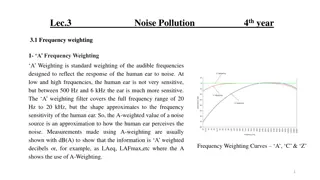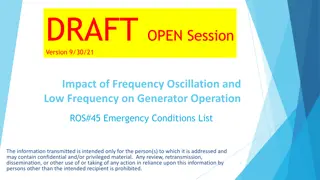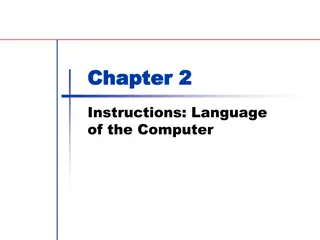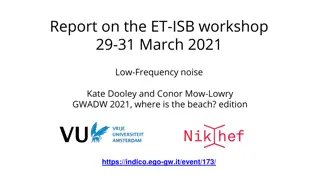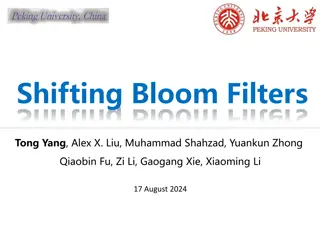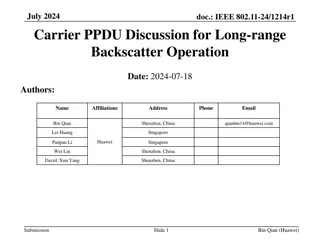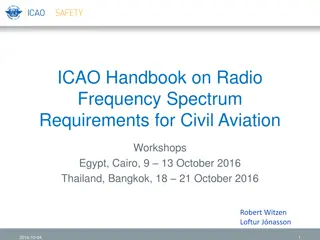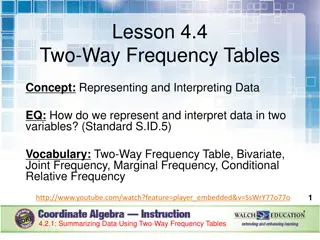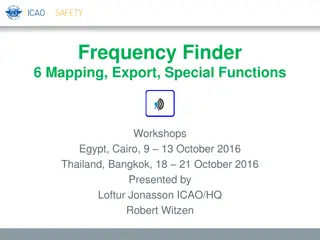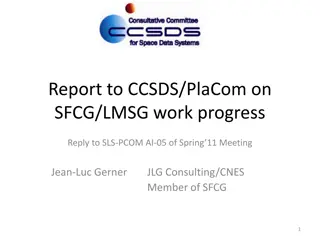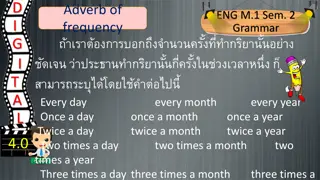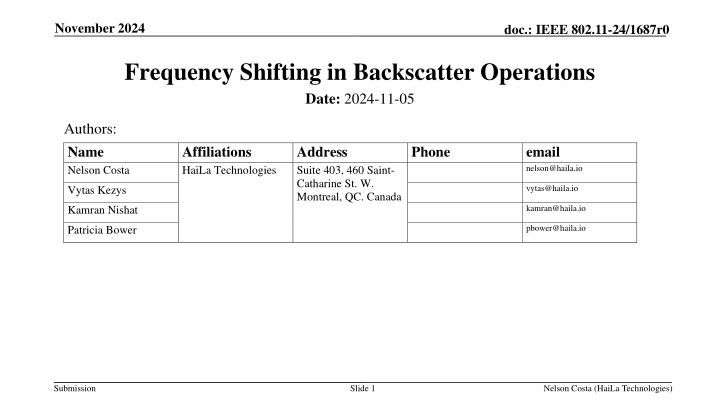
Effective Self-Jamming Mitigation Using Frequency Shifting in Backscatter Operations
Explore how frequency shifting can effectively reduce self-jamming in long-range backscatter operations within the context of IEEE 802.11 standards. This method increases orthogonality at the receiver by shifting the reflected signal in frequency, introducing more link margin and separating desired signals from interferers. Discover the advantages of frequency diversity through Miller encoding to enhance signal-to-interference margins, enabling long-range backscatter with a cost-efficient architecture.
Download Presentation

Please find below an Image/Link to download the presentation.
The content on the website is provided AS IS for your information and personal use only. It may not be sold, licensed, or shared on other websites without obtaining consent from the author. If you encounter any issues during the download, it is possible that the publisher has removed the file from their server.
You are allowed to download the files provided on this website for personal or commercial use, subject to the condition that they are used lawfully. All files are the property of their respective owners.
The content on the website is provided AS IS for your information and personal use only. It may not be sold, licensed, or shared on other websites without obtaining consent from the author.
E N D
Presentation Transcript
November 2024 doc.: IEEE 802.11-24/1687r0 Frequency Shifting in Backscatter Operations Date: 2024-11-05 Authors: Name Nelson Costa Affiliations HaiLa Technologies Address Suite 403, 460 Saint- Catharine St. W. Montreal, QC. Canada Phone email nelson@haila.io vytas@haila.io Vytas Kezys kamran@haila.io Kamran Nishat pbower@haila.io Patricia Bower Submission Slide 1 Nelson Costa (HaiLa Technologies)
November 2024 doc.: IEEE 802.11-24/1687r0 Abstract This presentation discusses the concept of frequency shifting as an effective method to reducing self-jamming in long range backscatter operations. Submission Slide 2 Nelson Costa (HaiLa Technologies)
November 2024 doc.: IEEE 802.11-24/1687r0 Background: Self Jamming in Backscatter Operations In the context of 802.11, backscattering a signal involves reflecting a signal already present on the air, and modifying its contents while reflecting it. In long range backscattering, the original (the interferer) and reflected (the desired) signals compete with each other over the air. The original signal is often the loudest interferer. The limiting factor in link margins is often determined by the power in the original signal versus the power of the reflected signal as seen by the receiver. We call this interference self-jamming . Submission Slide 3 Nelson Costa (HaiLa Technologies)
November 2024 doc.: IEEE 802.11-24/1687r0 Self-Jamming Mitigation: Frequency Shifting We can increase orthogonality at the receiver by using frequency shifting. We can shift the reflected signal up or down in frequency by mixing the signal with a clock. Shifting the original signal away in frequency introduces more link margin in that it separates the desired signal from the interferer in frequency. All else being equal, the receiver is tuned to a different channel than the transmitter. Its ability to successfully decode the reflected signal becomes a function of The receiver s ability to reject adjacent channel interference. The receiver s ability to decode a signal in the presence of an in-band and co-channel interferer. Submission Slide 4 Nelson Costa (HaiLa Technologies)
November 2024 doc.: IEEE 802.11-24/1687r0 Self-Jamming Mitigation: Frequency Diversity [1] the authors presented a frequency diversity method that used Miller encoding to create sub-carriers within a given channel. Shifting the original signal into a separate channel has the following advantages. Biggest advantage: it introduces > 50 dB signal-to-interference margin, enabling long range backscatter. Simple cost-efficient architecture. It reuses existing PHY functions at the transmitter and receiver. It increases the interference-to-noise ratio by shifting further in frequency. (This modulation scheme is not limited to the same channel width) Shifting by multiples of the channel width maintains PHY compatibility at the receiver. This method uses the full bandwidth of the channel. This method is compatible with different waveforms (it doesn t propose creating a new waveform specifically for backscattering). Submission Slide 5 Nelson Costa (HaiLa Technologies)
November 2024 doc.: IEEE 802.11-24/1687r0 Self-Jamming Mitigation: Frequency Shifting (2) 50 dB due mostly to frequency shift from channel 1 to 11 ( at 50MHz ). 5 dB lost at the tag due to backscatter efficiency, other losses. -35 dBm RX sensitivity ; the threshold below which the tag cannot hear downlink sequences, and thus cannot backscatter. Submission Slide 6 Nelson Costa (HaiLa Technologies)
November 2024 doc.: IEEE 802.11-24/1687r0 References [1] Dunna et al., Frequency translation backscatter, IEEE 802.11- 24/1543r1, Sept. 10, 2024. Submission Slide 7 Nelson Costa (HaiLa Technologies)
November 2024 doc.: IEEE 802.11-24/1687r0 Self-Jamming Mitigation: Frequency Shifting (3) Submission Slide 8 Nelson Costa (HaiLa Technologies)
November 2024 doc.: IEEE 802.11-24/1687r0 Notes: Adjacent Channel Rejection in 802.11 16.4.8.4 (DSSS PHY) Conditions, rejection shall be 35 dB Adjacent channel is 30 MHz (Channel (1 -> 7 -> 13 (!)) 8% FER 2 Mbps DQPSK 1024 byte MPDU Our case is worse; receivers are more sensitive to lower order modulation (DBPSK), which shows up as higher sensitivity to adjacent interference. There are no other definitions at any other modulation nor channel separation. Our testing with 1 Mbps DBPSK shows we need 52 dB separation at a 50 MHz separation (Interferer on channel 1, receiver on channel 11) Submission Slide 9 Nelson Costa (HaiLa Technologies)


